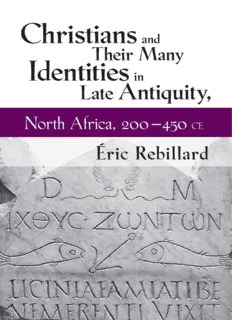
Christians and Their Many Identities in Late Antiquity, North Africa, 200-450 CE PDF
Preview Christians and Their Many Identities in Late Antiquity, North Africa, 200-450 CE
• CHRISTIANS AND THEIR MANY IDENTITIES IN LATE ANTIQUITY, NORTH AFRICA, 200–450 CE CHRISTIANS AND THEIR MANY IDENTITIES n IN LATE ANTIQUITY, NORTH AFRICA, 200–450 CE Éric Rebillard CORNELL UNIVERSITY PRESS Ithaca and London Copyright © 2012 by Cornell University All rights reserved. Except for brief quotations in a review, this book, or parts thereof, must not be reproduced in any form without permission in writing from the publisher. For information, address Cornell University Press, Sage House, 512 East State Street, Ithaca, New York 14850. First published 2012 by Cornell University Press Printed in the United States of America Library of Congress Cataloging-in-Publication Data Rebillard, Éric. Christians and their many identities in late antiquity, North Africa, 200–450 CE / Éric Rebillard. p. cm. Includes bibliographical references and index. ISBN 978-0-8014-5142-3 (cloth : alk. paper) 1. Africa, North—Church history. 2. Church history— Primitive and early church, ca. 30–600. 3. Christian life— History—Early church, ca. 30–600. I. Title. BR190.R43 2013 276.1′02—dc23 2012020509 Cornell University Press strives to use environmentally responsible suppliers and materials to the fullest extent possible in the publishing of its books. Such materials include vegetable-based, low-VOC inks and acid-free papers that are recycled, totally chlorine-free, or partly composed of nonwood fibers. For further information, visit our website at www.cornellpress.cornell.edu. Cloth printing 10 9 8 7 6 5 4 3 2 1 • Contents Acknowledgments vii Note on Primary Sources ix Introduction 1 1. Setting the Stage: Carthage at the End of the Second Century 9 2. Persecution and the Limits of Religious Allegiance 34 3. Being Christian in the Age of Augustine 61 Conclusion 92 Notes 99 Bibliography 109 Index 127 • Acknowledgments The research for this book started (too long ago) in the very congenial and productive context of the program Les identités religieuses dans les mondes grec et romain d’Alexandre à Justinien, directed by Nicole Belayche and Simon Mimouni (Paris, 2001–2005). Mark Vessey’s invi- tation to contribute a chapter to his Companion to Augustine came at the right time to set me back to work on the topic of being Christian in late antiquity. The conceptual framework of the project was refined and tuned during a grad- uate seminar at Cornell University in 2010. With their patience and inquisi- tiveness the participants helped me tighten up my approach. Jörg Rüpke’s generous invitation to join the Max-Weber Kolleg für kultur- und sozialwis- senschaftliche Studien (Erfurt Universität) as a fellow in 2010–2011 provided invaluable time for writing and audiences for discussion. I thank all the fellows, students, and staff members of the MWK for welcoming me and my family in Erfurt and making our year there so fruitful. I also thank Jörg for reading the first draft of the whole book and making many insightful comments. The final version of the book was written—and many references checked—in Oxford. I thank Neil McLynn for facilitating my election as Visiting Scholar at Corpus Christi for Michaelmas and Hilary Terms. Special thanks are due to the chair of the department of classics, Charles Brittain, to the dean of the College of Arts and Science, and to the provost of Cornell University for allowing and funding a second year of leave. I owe encouragements and forceful comments to Claire Sotinel who read a very early draft of the introduction and first two chapters. Peter Brown was inspirational early in the project, when he directed my atten- tion to Rogers Brubaker’s ethnographical work. I wish I could have included all the conclusions he invited me to draw after reading the final draft of the book. I must acknowledge the invaluable work of Alice Brigance, who not only care- fully edited my English text but also helped me clarify many points with her questions and comments. Linda Brown’s help has been vital, fetching books or articles left in my office at Cornell and sending scanned versions of them almost instantaneously. Last, but not least, my thanks go to my wife, Suzanne, and my son, Emile, who cheerfully followed me to Germany and England! vii • Note on Primary Sources Abbreviations for works are those of the Thesaurus Linguae Latinae for Latin texts and of the Diccionario Griego-Español (DGE) for Greek texts. Translations are mine unless otherwise acknowledged in the notes. ix
Description: